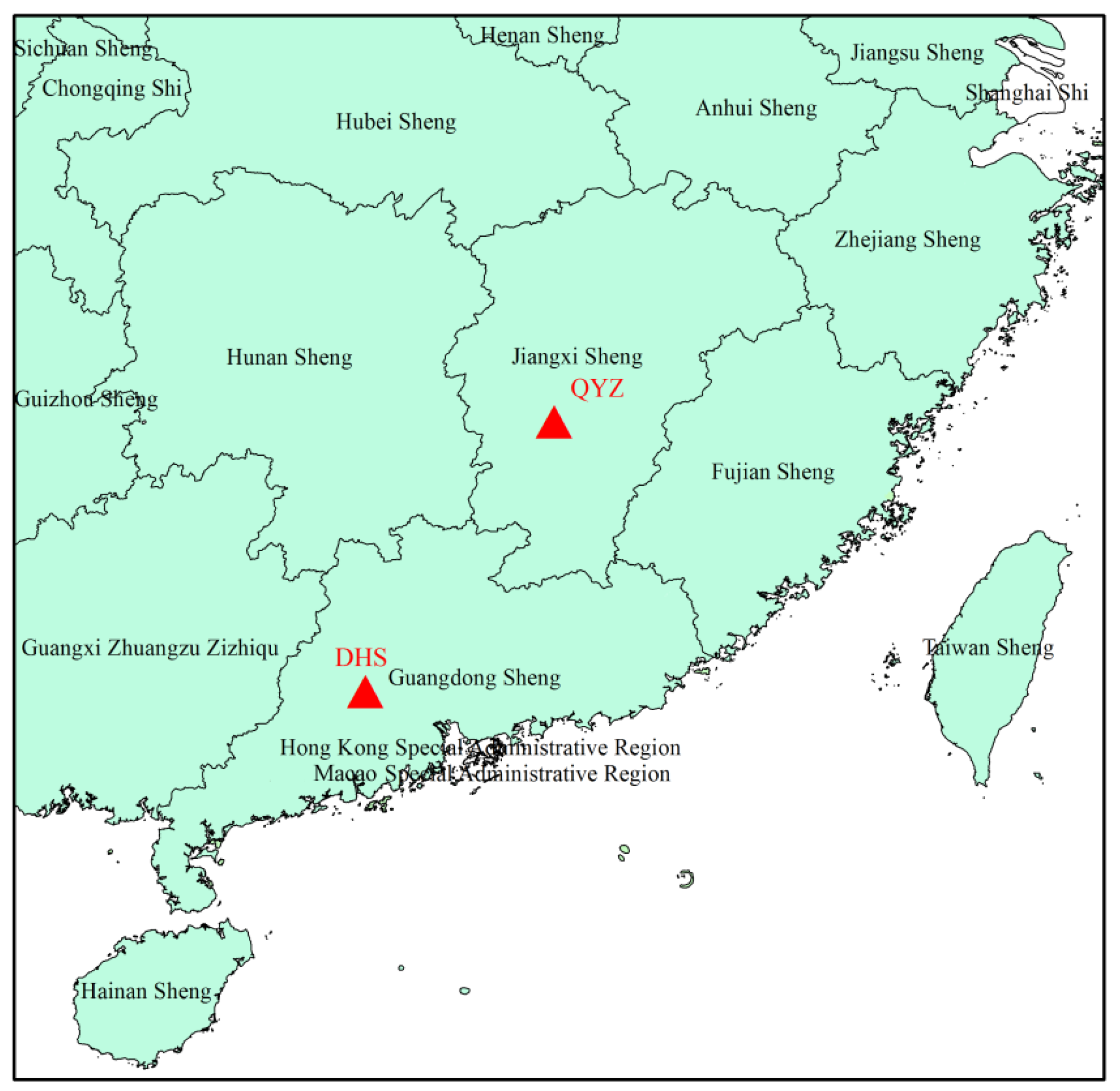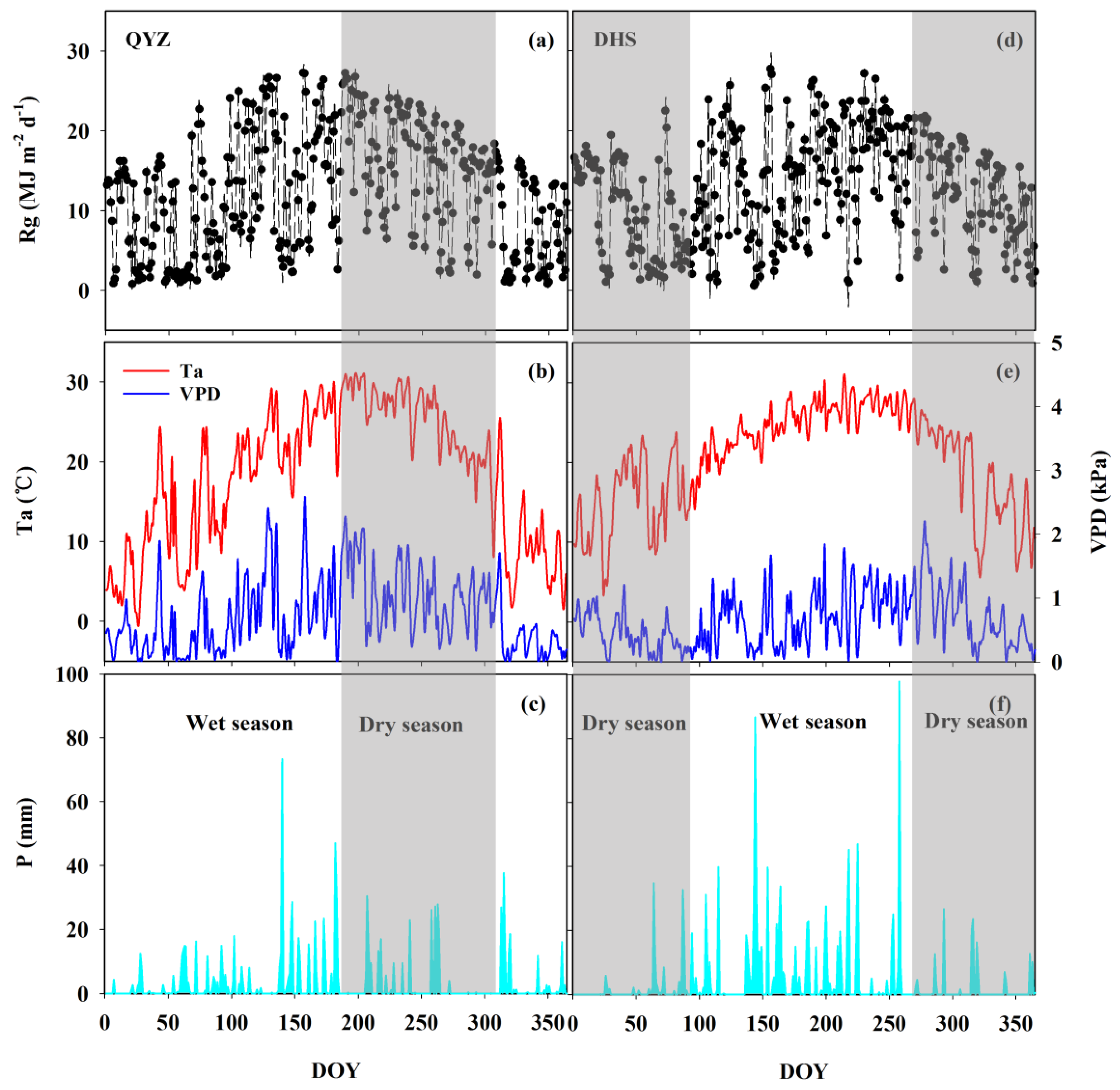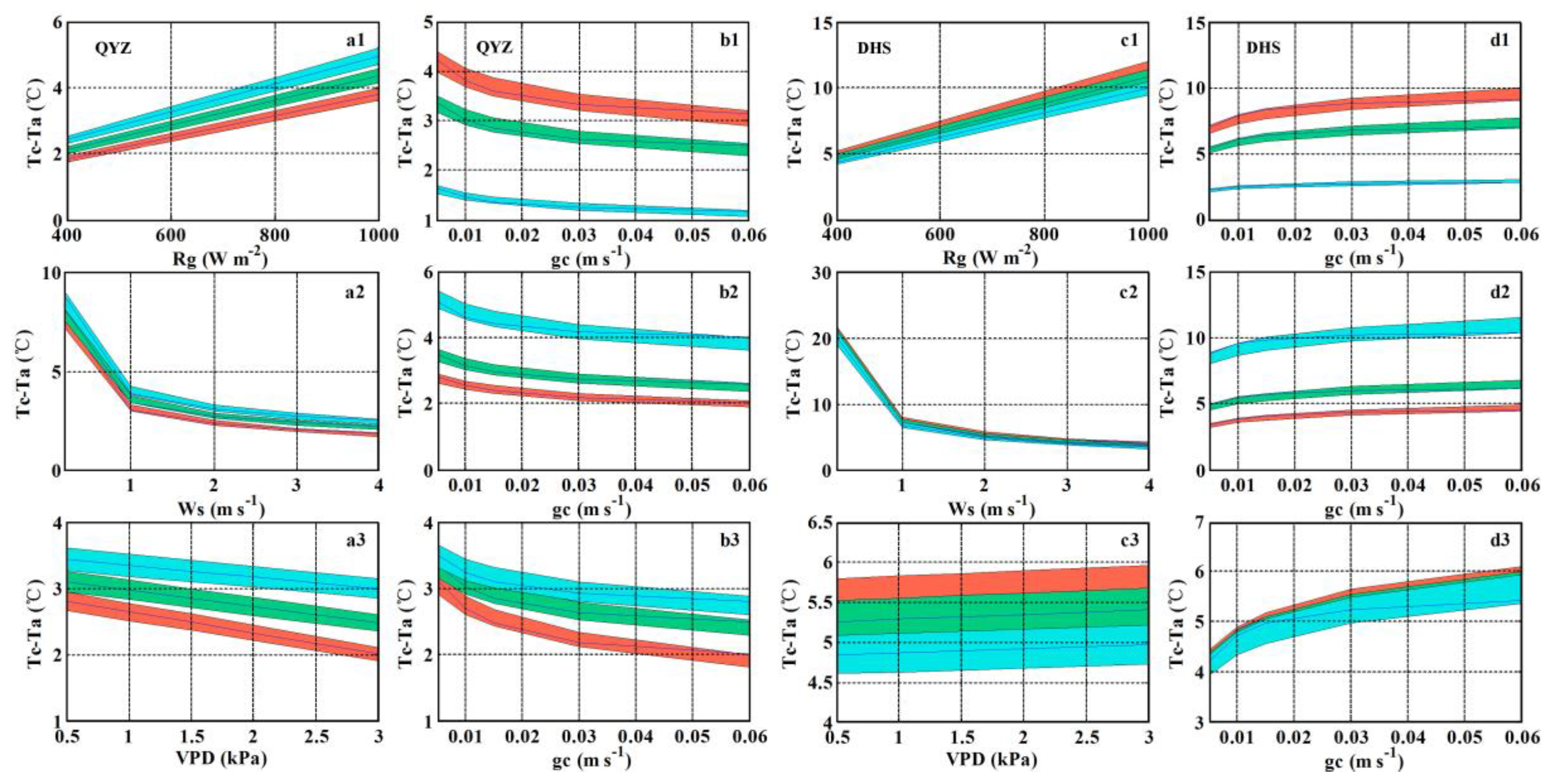Contrasting Temperature and Precipitation Patterns of Trees in Different Seasons and Responses of Infrared Canopy Temperature in Two Asian Subtropical Forests
Abstract
1. Introduction
2. Materials and Methods
2.1. Site Description
2.2. Tc and Meteorological Factor Measurements
2.3. Canopy Conductance
2.4. Sensitivity of Tc to Environmental Factor Change
2.5. Data Analysis
3. Results
3.1. Seasonal Variation of Meteorological Factors
3.2. Diurnal Variations of Tc and Other Factors
3.3. Seasonal Variations of Tc and Other Factors
3.4. Sensitivity of ΔT to Changes in Environmental Factors
4. Discussion
5. Conclusions
Supplementary Materials
Author Contributions
Funding
Acknowledgments
Conflicts of Interest
References
- Leuzinger, S.; Korner, C. Tree species diversity affects canopy leaf temperatures in a mature temperate forest. Agric. For. Meteorol. 2007, 146, 29–37. [Google Scholar] [CrossRef]
- Blonquist, J.M.; Norman, J.M.; Bugbee, B. Automated measurement of canopy stomatal conductance based on infrared temperature. Agric. For. Meteorol. 2009, 149, 1931–1945. [Google Scholar] [CrossRef]
- Jarvis, P.G.; Mcnaughton, K.G. Stomatal control of transpiration: Scaling up from leaf to region. Adv. Ecol. Res. 1986, 15, 1–49. [Google Scholar]
- Scherrer, D.; Bader, M.K.F.; Korner, C. Drought-sensitivity ranking of deciduous tree species based on thermal imaging of forest canopies. Agric. For. Meteorol. 2011, 151, 1632–1640. [Google Scholar] [CrossRef]
- Meier, F.; Scherer, D. Spatial and temporal variability of urban tree canopy temperature during summer 2010 in Berlin, Germany. Theor. Appl. Climatol. 2012, 110, 373–384. [Google Scholar] [CrossRef]
- Song, Q.H.; Deng, Y.; Zhang, Y.P.; Deng, X.B.; Lin, Y.X.; Zhou, L.G.; Fei, X.H.; Sha, L.Q.; Liu, Y.T.; Zhou, W.J.; et al. Comparison of infrared canopy temperature in a rubber plantation and tropical rain forest. Int. J. Biometeorol. 2017, 61, 1885–1892. [Google Scholar] [CrossRef] [PubMed]
- Song, Q.H.; Zhang, Y.P.; Sha, L.Q.; Deng, X.B.; Deng, Y.; Wu, C.S.; Lu, Z.Y.; Chen, A.G.; Zhang, S.B.; Li, G.; et al. Canopy temperature variability in a tropical rainforest, subtropical evergreen forest, and savanna forest in Southwest China. Iforest-Biogeosci. For. 2017, 10, 611–617. [Google Scholar] [CrossRef]
- Gessler, A.; Keitel, C.; Kreuzwieser, J.; Matyssek, R.; Seiler, W.; Rennenberg, H. Potential risks for European beech (Fagus sylvatica L.) in a changing climate. Trees Struct. Funct. 2007, 21, 1–11. [Google Scholar] [CrossRef]
- Zweifel, R.; Rigling, A.; Dobbertin, M. Species-specific stomatal response of trees to drought - a link to vegetation dynamics? J. Veg. Sci. 2009, 20, 442–454. [Google Scholar] [CrossRef]
- Ballester, C.; Jiménez-Bello, M.A.; Castel, J.R.; Intrigliolo, D.S. Usefulness of thermography for plant water stress detection in citrus and persimmon trees. Agric. For. Meteorol. 2013, 168, 120–129. [Google Scholar] [CrossRef]
- Campbell, G.S.; Norman, J.M. Estimation of plant water status from canopy temperature: An analysis of the inverse problem. In Applications of Remote Sensing in Agriculture; Steven, M.D., Clark, J.A., Eds.; Butterworths: London, UK, 1990. [Google Scholar]
- Jones, H.G. Use of infrared thermometry for estimation of stomatal conductance as a possible aid to irrigation scheduling. Agric. For. Meteorol. 1999, 95, 139–149. [Google Scholar] [CrossRef]
- Yu, G.R.; Chen, Z.; Piao, S.L.; Peng, C.H.; Philippe, C.; Wang, Q.F.; Li, X.R.; Zhu, X.J. High carbon dioxide uptake by subtropical forest ecosystems in the East Asian monsoon region. Proc. Natl. Acad. Sci. USA 2014, 111, 4910–4915. [Google Scholar] [CrossRef] [PubMed]
- Yan, J.H.; Zhang, Y.P.; Yu, G.R.; Zhou, G.Y.; Zhang, L.M.; Li, K.; Tan, Z.L.; Sha, L.Q. Seasonal and inter-annual variations in net ecosystem exchange of two old-growth forests in southern China. Agric. For. Meteorol. 2013, 182–183, 257–265. [Google Scholar] [CrossRef]
- Yu, G.R.; Zhang, L.M.; Sun, X.M.; Fu, Y.L.; Wen, X.F.; Wang, Q.F.; Li, S.G.; Ren, C.Y.; Song, X.; Liu, Y.F.; et al. Environmental controls over carbon exchange of three forest ecosystems in eastern China. Glob. Chang. Biol. 2008, 14, 2555–2571. [Google Scholar] [CrossRef]
- Tang, Y.K.; Chen, Y.M.; Wen, X.F.; Sun, X.M.; Wu, X.; Wang, H.M. Variation of carbon use efficiency over ten years in a subtropical coniferous plantation in southeast China. Ecol. Eng. 2016, 97, 196–206. [Google Scholar] [CrossRef]
- Wen, X.F.; Wang, H.M.; Wang, J.L.; Yu, G.R. Ecosystem carbon exchanges of a subtropical evergreen coniferous plantation subjected to seasonal drought, 2003–2007. Biogeosciences 2010, 7, 357–369. [Google Scholar] [CrossRef]
- Baldocchi, D. On using eco-physiological, micrometeorological and biogeochemical thoery to evaluate carobn dioxide, water vapor and trace gas fluxes over vegettion: A perspetive. Agric. For. Meteorol. 1998, 90, 1–25. [Google Scholar] [CrossRef]
- Monteith, J.L.; Unsworth, M.H. Principles of Environmental Physics, 2nd ed.; Elsevier: Amesterdam, The Netherlands, 2008. [Google Scholar]
- Ryu, Y.; Baldocchi, D.D.; Ma, S.; Hehn, T. Interannual variability of evapotranspiration and energy exchange over an annual grassland in California. J. Geophys. Res. Atmos. 2008, 113, 1–16. [Google Scholar] [CrossRef]
- Monin, A.S.; Obukhov, A.M. Basic laws of turbulent mixing in the ground layer of the atmosphere. Tr. Geofiz. st. Akad. Nauk, SSSR no. 24. In Sammelband zur Statistischen Theorie der Turulenz (German translation 1958); Goering, H., Ed.; Akademie Verlag: Berlin, Germany, 1954. [Google Scholar]
- Yu, G.R. Progress in evapotranspiration models for terrestrial vegetation of different canopy types. Resour. Sci. 2001, 23, 72–84. [Google Scholar]
- Maes, W.H.; Steppe, K. Estimating evapotranspiration and drought stress with ground-based thermal remote sensing in agriculture: A review. J. Exp. Bot. 2012, 63, 4671–4712. [Google Scholar] [CrossRef]
- Monteith, J.L. Principles of Environmental Physics; Edward Arnold: London, UK, 1973. [Google Scholar]
- Yang, Z.; Zhang, Y.P.; Yu, G.R.; Zhao, S.J.; Song, Q.H.; Gao, J.M. Characteristics of canopy and air temperature in tropical seasonal rainforests in Xishuangbanna. Chin. J. Ecol. 2009, 28, 845–849. [Google Scholar]
- Still, C.; Powell, R.; Aubrecht, D.; Kim, Y.; Helliker, B.; Roberts, D.; Richardson, A.D.; Goulden, M. Thermal imaging in plant and ecosystem ecology: Applications and challenges. Ecosphere 2019, 10, e02768. [Google Scholar] [CrossRef]
- Maes, W.H.; Achten, W.M.J.; Reubens, B.; Muys, B. Monitoring stomatal conductance of Jatropha curcas seedlings under different levels of water shortage with infrared thermography. Agric. For. Meteorol. 2011, 151, 554–564. [Google Scholar] [CrossRef]
- Saito, T.; Kumagai, T.; Tateishi, M.; Kobayashi, N.; Otsuki, K.; Giambelluca, T.W. Differences in seasonality and temperature dependency of stand transpiration and canopy conductance between Japanese cypress (Hinoki) and Japanese cedar (Sugi) in a plantation. Hydrol. Process 2017, 31, 1952–1965. [Google Scholar] [CrossRef]
- Yu, G.R.; Song, X.; Wang, Q.F.; Liu, Y.F.; Guan, D.X.; Yan, J.H.; Sun, X.M.; Zhang, L.M.; Wen, X.F. Water-use efficiency of forest ecosystems in eastern China and its relations to climatic variables. New Phytol. 2008, 177, 927–937. [Google Scholar] [CrossRef] [PubMed]
- Bates, B.C.; Kundzewicz, Z.W.; Wu, S.; Palutikof, J.P. Climate change and water. In Technical Paper of the Intergovernmental Panel on Climate Change; IPCC Secretariat: Geneva, Switzerland, 2008. [Google Scholar]
- IPCC. Summary for Policymakers. In Climate Change 2013: The Physical Science Basis. Contribution of Working Group I to the Fifth Assessment Report of the Intergovernmental Panel on Climate Change; Stocker, T.F., Qin, D., Plattner, G.K., Tignor, M., Allen, S.K., Boschung, J., Nauels, A., Xia, Y., Bex, V., Midgley, P.M., Eds.; Cambridge University Press: Cambridge, UK; New York, NY, USA, 2013. [Google Scholar]
- Chevuturi, A.; Klingaman, N.P.; Turner, A.G.; Hannah, S. Projected changes in the Asian-Australian monsoon region in 1.5 °C and 2.0 °C global-warming scenarios. Earth’s Fut. 2018, 6, 339–358. [Google Scholar] [CrossRef]





| Sites | DHS | QYZ |
|---|---|---|
| Location | 23°10′16″ N, 112°31′48″ E | 26°44′52″ N, 115°03′47″ E |
| Elevation(m) | 300 | 102 |
| Mean annual temperature (°C) | 20.5 | 17.9 |
| Total rainfall (mm) | 1700 | 1472.8 |
| Predominant species | Castanopsis chinensis, Schima superba, Cryptocarya chinensis | Pinus massoniana Lamb, Pinus elliottii Engelm, Cunninghamia lanceolata Hook |
| Canopy height (m) | 22 | 13 |
| Leaf area index | 4 | 3.5 |
| Soil type | lateritic red earth | red earth |
| Soil Ph | 3.8 | 4.7 |
| Soil bulk density (g cm−3) | 1.01 | 1.57 |
| Measurement of canopy temperature (height) | 32 m | 23 m |
| Measurement of air temperature, relative humidity, and wind speed (height) | 32 m | 23 m |
| Measurement of radiation (height) | 36 m | 39 m |
| Measurement of soil volumetric water content (depth) | 5 cm | 5 cm |
| Measurement of soil temperature (depth) | 5 cm | 5 cm |
| Measurement of soil heat flux (depth) | 5 cm | 5 cm |
| Measurement of precipitation (height) | 36 m | 39 m |
| Parameters | QYZ | DHS | ||||
|---|---|---|---|---|---|---|
| Dry Season (Jul–Oct) | Wet Season (Nov–Jun) | Annual | Dry Season (Oct–Mar) | Wet Season (Apr–Sep) | Annual | |
| Rg | 16.44 | 10.64 | 12.59 | 10.75 | 14.23 | 12.49 |
| Ta | 25.63 | 14.60 | 18.28 | 16.26 | 24.71 | 20.49 |
| VPD | 1.05 | 0.56 | 0.72 | 0.57 | 0.70 | 0.63 |
| Ts | 24.23 | 14.54 | 17.77 | 17.18 | 23.61 | 20.39 |
| Swc | 0.13 | 0.17 | 0.16 | 0.17 | 0.24 | 0.20 |
| P | 339 | 676 | 1015 | 298 | 1056 | 1354 |
| Parameters | QYZ | DHS | ||||||
|---|---|---|---|---|---|---|---|---|
| Dry Season | Wet Season | Dry Season | Wet Season | |||||
| R2 | p | R2 | p | R2 | p | R2 | p | |
| Rg | 0.956 | <0.001 *** | 0.959 | <0.001 *** | 0.955 | <0.001 *** | 0.952 | <0.001 *** |
| Ta | 0.273 | <0.001 *** | 0.206 | 0.001 ** | 0.225 | 0.003 ** | 0.232 | 0.001 ** |
| VPD | 0.162 | 0.005 ** | 0.143 | 0.008 ** | 0.226 | 0.003 ** | 0.182 | 0.003 ** |
| Ws | 0.326 | <0.001 *** | 0.451 | <0.001 *** | 0.025 | 0.287 | 0.150 | 0.006 ** |
| SWC | 0.146 | 0.007 ** | 0.466 | <0.001 *** | 0.024 | 0.296 | 0.349 | <0.001 *** |
| Rg | Ta | VPD | Ws | SWC | gc | |||
|---|---|---|---|---|---|---|---|---|
| QYZ | Dry season | R2 | 0.588 | 0.094 | 0.393 | 0.137 | 0.093 | 0.077 |
| P | <0.001 | 0.001 | <0.001 | <0.001 | 0.001 | 0.003 | ||
| ss% | 58.8 | 3.2 | 10.9 | 17.6 | 0.1 | 0.2 | ||
| Wet season | R2 | 0.691 | 0.164 | 0.383 | 0.127 | 0.001 | 0.032 | |
| P | <0.001 | <0.001 | <0.001 | <0.001 | 0.699 | 0.012 | ||
| ss% | 69.1 | 0.1 | 3.8 | 9.4 | - | 0.4 | ||
| DHS | Dry season | R2 | 0.795 | 0.129 | 0.628 | 0.136 | 0.119 | 0.173 |
| P | <0.001 | <0.001 | <0.001 | <0.001 | <0.001 | <0.001 | ||
| ss% | 79.5 | 0.2 | 2.4 | 6.4 | 0.1 | 3.2 | ||
| Wet season | R2 | 0.315 | 0.058 | 0.223 | 0.150 | 0.104 | 0.012 | |
| P | <0.001 | <0.001 | <0.001 | <0.001 | <0.001 | 0.279 | ||
| ss% | 31.5 | 0.8 | 1.9 | 3.1 | 2.9 | - |
| Sites | Models | Adjusted-R2 | RMSE ( °C) |
|---|---|---|---|
| QYZ | 0.857 | 0.333 | |
| DHS | 0.942 | 0.543 |
© 2019 by the authors. Licensee MDPI, Basel, Switzerland. This article is an open access article distributed under the terms and conditions of the Creative Commons Attribution (CC BY) license (http://creativecommons.org/licenses/by/4.0/).
Share and Cite
Chen, Z.; Yu, G.; Yan, J.; Wang, H. Contrasting Temperature and Precipitation Patterns of Trees in Different Seasons and Responses of Infrared Canopy Temperature in Two Asian Subtropical Forests. Forests 2019, 10, 902. https://doi.org/10.3390/f10100902
Chen Z, Yu G, Yan J, Wang H. Contrasting Temperature and Precipitation Patterns of Trees in Different Seasons and Responses of Infrared Canopy Temperature in Two Asian Subtropical Forests. Forests. 2019; 10(10):902. https://doi.org/10.3390/f10100902
Chicago/Turabian StyleChen, Zhi, Guirui Yu, Junhua Yan, and Huimin Wang. 2019. "Contrasting Temperature and Precipitation Patterns of Trees in Different Seasons and Responses of Infrared Canopy Temperature in Two Asian Subtropical Forests" Forests 10, no. 10: 902. https://doi.org/10.3390/f10100902
APA StyleChen, Z., Yu, G., Yan, J., & Wang, H. (2019). Contrasting Temperature and Precipitation Patterns of Trees in Different Seasons and Responses of Infrared Canopy Temperature in Two Asian Subtropical Forests. Forests, 10(10), 902. https://doi.org/10.3390/f10100902





